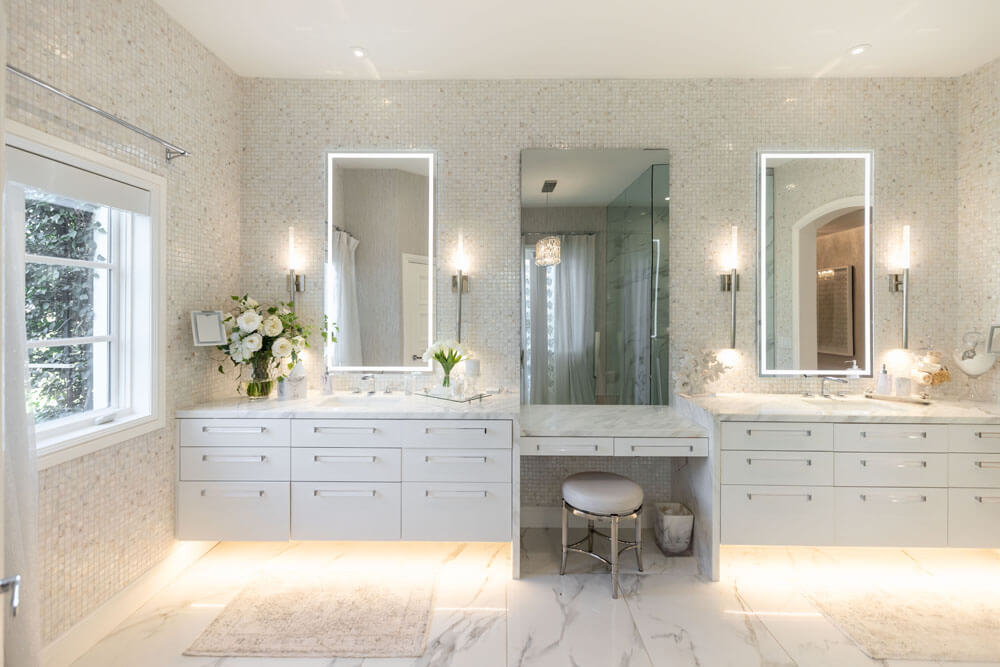Do you find the relationship between the main parties involved in construction somewhat confusing? You’re so not alone. Creating a residential property is a complex process that relies heavily on the collaboration of many parties, particularly architects and builders. To make it even more challenging, once clearly distinguished, the roles of architects and constructors now intertwine in a new category: a residential design-build contractor.
We will help you clear it all up by exploring the historical context of their partnership, outlining their contributions, and examining the advantages and challenges of integrated project delivery.
Traditional Role Separation
Architects and builders perform distinctly delineated assignments and responsibilities. Their roles gradually evolved throughout history but haven’t changed much in essence.
- Architects: Responsible for designing buildings, focusing on aesthetics, spatial planning, and functionality. They produce detailed plans and specifications that outline every design aspect, from structural elements to finishes.
- Builders: Tasked with interpreting these plans and managing the construction process. They focus on the practical aspects of structure, including material procurement, labor management, and adherence to building codes.
The Architect’s Role
Conceptualization and Design
At the beginning of the design process, architects thoroughly analyze the client’s requirements, including:
- spatial needs,
- aesthetic preferences
- budgetary constraints
Their next step is to develop detailed architectural drawings and specifications according to the acquired information.
This project phase includes floor plans, elevations, and sections, all created to be functional and visually appealing and provide clear guidance for the construction team.
Technical Proficiency and Creativity
Architects’ job balances creativity with technical proficiency. It’s not enough to produce something visually appealing: the design must be structurally sound and compliant with building codes. This requires a deep understanding of architectural principles, engineering concepts, and regulatory requirements. A variety of tools, including computer-aided design (CAD) software and 3D modeling, are a standard for creating accurate plans.
Client Interaction and Project Management
Communication between architects and clients is necessary if the final design is to match the client’s expectations. Architects listen to the client’s ideas, address concerns, and make necessary changes.
Additionally, architects have a straightforward role in project management. They coordinate with builders and other stakeholders to make sure the construction follows the design plans, keeps project on track and meets the expected standards.
The Builder’s Role
Interpretation and Execution
Builders are responsible for bringing architectural designs to life. Their primary task is to interpret the plans provided by the architect and manage their application through a scope of activities, from site preparation and foundation work to framing, roofing, and finishing.
Project Management and Coordination
Builders oversee the entire construction process, coordinating with subcontractors, suppliers, and inspectors to ensure a smooth progression. They are typically responsible for scheduling, budgeting, and ensuring that all work meets quality standards and complies with regulatory requirements.
Quality Control and Problem-Solving
The designers have particular responsibilities; however, the quality and integrity of the realized structure depend largely on the builders. Hence, they should conduct regular inspections to identify and address any issues that arise during the building process. Builders must be adept at problem-solving and finding practical solutions to unexpected challenges, all while maintaining the overall vision of the project.
The Rise of the Design-Build Model
During the mid-20th century, the construction industry began to recognize the limitations of this traditional approach, mostly due to the issues that shed light on its flaws. Above all, miscommunication between architects and builders too often led to delays, cost overruns, and compromises in design quality. The need was apparent for something more streamlined that could bridge the gaps, improve efficiency, and enhance accountability.
One logical solution has gained considerable traction. It introduced a new concept: “residential design-build contractor,” a single entity that oversees both the design and construction phases and streamlines the procedures. In essence, a design-build firm can offer a seamless project experience superior to traditional models, reducing the potential for conflicts and ensuring that the final product aligns closely with the original vision.
Advantages of the Design-Build Model
Streamlined Communication: A single point of contact eliminates the gaps in the chain. Design and construction teams work together from the project’s inception to its ending, with everyone on the same page.
- Enhanced Efficiency: Projects proceed swiftly when design and construction phases are coordinated to the last detail. The benefits are shorter project timelines and earlier completion dates.
- Cost Savings: A unified approach means more effective budget management, financial transparency, and lower risks of cost overruns.
Challenges and Solutions
Of course, nothing is perfect. Integrated teams must navigate the complexities of both design and construction, which can be demanding. Balancing creative differences between architects and builders requires effective communication, as well as proper mutual respect, which is why successful design-build firms develop robust processes and communication strategies.
Architects vs. Builders
Although the roles are related, there are still some clearly set boundaries between architects and builders in residential design.
What Architects Do Not Do
Construction Management
Architects design and plan the structure—they typically do not manage the day-to-day construction activities. This includes overseeing the work of subcontractors, scheduling tasks, and handling on-site logistics.
Material Procurement
Architects do specify the materials needed for a project but rarely handle the procurement process. That responsibility falls to the builders, who purchase them and manage the delivery.
On-Site Supervision
Architects’ visits to the site are obligatory to ensure their designs are being followed correctly. That, however, doesn’t mean they supervise the construction crew on a daily basis. Builders take charge of on-site supervision, ensuring the work is executed according to plan and within safety regulations.
What Builders Do Not Do
Design and Planning
It is not common for builders to engage in the initial design and planning phase, although they may offer practical input on construction feasibility. The creative vision and detailed drawings are the architect’s domain.
Regulatory Approvals
While builders ensure construction complies with local codes, it’s not their job to handle the submission of design plans for regulatory approvals. Architects prepare and submit these documents to obtain necessary permits before construction begins.
Conceptual Development
Builders rarely engage in the conceptual development of the project. They implement the architect’s vision rather than creating the initial design concepts and spatial layouts.
Common Misconceptions About the Architect-Builder Relationship
- Architects and Builders are Always at Odds
One relatively common misconception is that architects and builders are inherently at odds with each other. While it’s true that they have different focuses—design versus construction—their roles are complementary rather than conflicting. In fact, the most successful projects are those where each party showcases the ability to collaborate and leverage each other’s expertise.
- Design-Build Compromises Quality for Speed
Another misconception is that the design-build model prioritizes speed over quality. In reality, the integrated approach eliminates the common source of hiccups in the process, thus boosting both efficiency and quality at the same time.
We mentioned the importance of collaboration. Design-build teams work together from the start, resulting in design decisions informed by practical construction considerations.
- Design-Build is More Expensive
Some believe the design-build model is just a pricier version of traditional methods. In reality, design-build projects often result in cost savings, mainly due to improved coordination, reduced delays, and more efficient resource use. The integrated approach often implies better budget management and fewer unexpected expenses.
- Homeowners Have Less Control
Homeowners sometimes worry that they will have less control over the project with a design-build contractor. The truth is quite the opposite. The integrated team works closely with you throughout the project with a clearly set goal: to realize your vision. Getting there requires that you are involved in all key decisions.
Wrapping Up
The relationship between architects and builders—and how they interact—determines the outcome of your project. Architects bring creative vision and precision to the table through detailed designs that comply with regulatory standards. Builders, on the other hand, translate these designs into reality, managing their practical aspects.
The advantage of the design-build model is that it further strengthens this collaboration. Integrating design and construction under one umbrella enables seamless communication and promotes coordinated efforts.
In essence, the context of residential design-build contractors is all about the synergy between architects and builders. By leveraging the strengths of both disciplines in one, you can confidently approach your project and expect remarkable results in return.
Contact us for more information on residential design-build contractors and the services offered by Woodcrest Design. Let’s transform your vision into reality, ensuring your home is beautiful—but also built to last!




